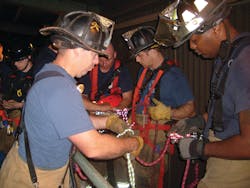On May 24, 2010, the Jersey City, NJ, Fire Department was dispatched for an industrial accident at the Public Service Electric and Gas (PSE&G) plant in Jersey City. The plant covers over 250 acres, with limited accessibility, and provides power to New Jersey, Pennsylvania and Maryland. It runs two boilers for making electricity, one on natural gas and one on coal. To run the coal unit, a stockpile of coal is kept at the site at all times. The pile of coal measures 500 feet by 500 feet and is more than 60 feet high. The coal is moved by three Caterpillar D9 bulldozers with 20-foot-wide blades into hoppers under the pile or to conveyers above the pile. The plant is run 24 hours a day, 365 days a year.
At 5:09 A.M., District 354 was transmitted by the Jersey City Fire Department's dispatch center for an industrial accident at the PSE&G plant at Van Keuren Avenue. On the response were 3rd Battalion Chief Joseph Zieja, Engines 7 and 11, Ladder 9, Rescue 1, the mask service unit (MSU) and the safety officer, Battalion Chief John Holinka. Each engine and ladder rides with a captain and three firefighters, the rescue with a captain and four firefighters, the battalions ride alone, and the MSU rides with a firefighter and the safety battalion. This response brought 20 personnel to the scene.
As the captain of Rescue 1, I was requested to meet with Zieja and the plant personnel on my arrival. Zieja informed me that one of the D9s had flipped over and the operator was trapped in the machine. We accompanied the plant personnel up a stairway to the conveyer system 50 feet above the pile. On the way up, I noticed a two-foot section of steel sticking up from the pile, with a D9 standing behind it. We reached a catwalk that ran along both sides of the conveyer and was six feet wide with a middle railing running its entire length. This reduced our working area. A three-foot opening at the bottom of the conveyer allowed the entire system to move across the pile.
From this vantage point, I could clearly see the machine in a hole with only two feet of the blade sticking up. This was the piece of metal I noticed as I was walking up the stairs. The machine was lying on its side with the back end lower than the front. The hole was 25 feet deep at the back of the machine and 18 feet deep at the blade. The hole was 60 feet around, with the ends undermined seven feet from the edge.
Due to the undermining of the edge, any approach from the pile was out of the question. This would only have caused the edge to collapse and bury the machine and operator even more. The cab of the machine could be seen, but the glass and doors were totally covered with four feet of coal. Contact with the operator was made by cell phone prior to our arrival. He reported that he was not injured, but could not get out of the cab of the machine.
Zieja and I concluded that our only way to gain access to the operator was to lower members the 50 feet from the conveyer system to the machine. Zieja ordered all machinery around the coal pile shut down, locked and tagged. This would stop any vibration in the area and keep more coal from falling into the hole, further burying the machine.
I then asked for Squad 4, Jersey City's light rescue with our Urban Areas Security Initiative (UASI) truck. The UASI system was put in place to assist municipalities in New Jersey with special operations incidents. The truck is equipped with rescue equipment, and the members of the department assigned to use the equipment are given special operations training. The state's urban search and rescue (USAR) team provides identical training to all members in the system. Eleven UASI units are in operation at 10 fire departments and the Port Authority of New York & New Jersey. Members of Jersey City Rescue 1 and Squad 4, with their alternates, drill with this equipment on a regular basis.
I then had all companies on scene start bringing up high-angle equipment to the catwalk. Once there, I dressed out four members in harnesses and helmets and prepped them on the job at hand. Firefighter Alex Degnan from Squad 4 and Steve Bryan from Rescue 1 were selected as the primary rescuers. Their backups were Firefighters Joe Novembre and Joe Vallo, both from Rescue 1.
Once all the equipment was in place, two 4-to-1 hauling systems and two lowering systems were set up, along with three safety lines. We used the structural steel of the catwalk as the anchor systems and padded the area in which the members would be lowered. I assigned Squad 4 Captain Steve Rykola as the tactical safety officer. He was to make sure all facets of the operation were set up properly and to set up communications with our members being lowered. The radios were set to a totally separate channel.
I used the crew of Engine 7 — Captain Michael Nickerson and Firefighters Ivan Ayala, Greg Greten and Harry Kawczka — to man one lowering hauling system. The crew of Ladder 9 — Captain Wayne Dombrowski and Firefighters Mike Mauer and Mike Berckes — were assigned to man the other lowering and hauling system. The systems were set up on opposite sides of the operational area. Firefighter William Clarrett from Rescue 1 and Firefighter Anthony DelFino from Ladder 9 handled the safety lines for the members being lowered. Firefighters Mike Mandriotta and Dan Healy from Squad 4 ran the safety line for the victim and filled in where needed.
The crew of Engine 11 — Captain Michael Suchdolski and Firefighters James Touy, Mike Vaughan and Denis McCarthy — was placed in staging to handle any needs that might arise. Firefighter Tony Lemanski from the MSU was staged on the ground for support purposes.
Once all the members and systems were in place and a check that all equipment had been locked and tagged out, a call was made to the trapped operator to see whether conditions had changed; he informed us that everything was the same. I told Rykola I was looking forward to meeting the trapped man in person. Through the entire operation, he remained calm and helpful, which made our job much easier.
I met with Zieja and Holinka to explain what was going to happen and how things were going to be handled. With their approval, and that of arriving Deputy Chief Michael Blanchard, the operation was started.
We lowered Degnan first. It took some time to get him through the opening between the conveyer and the catwalk. Once he reached the blade of the machine, he unhooked from the lowering system and, while still on his safety line, made his way down the arm of the machine to the cab. The coal dust made the machine very slippery, and if that was not bad enough, it started to rain, with the wind picking up. We then lowered Bryan, and the wind and rain made for an unpleasant trip. Once down to the machine, he made his way to the cab.
The coal covering the cab had to be removed by hand, because the coal that is used by the plant is unstable and the slightest spark could start a fire. As we watched from above, Rykola brought to my attention that the edges of the hole were undermined and our members were working very close to the one edge. This concern was paramount in my mind and I informed Bryan and Degnan to keep an eye on the edge. If at any time it seemed that it would collapse, they were to stay as clear from the edge as possible. Degnan worked to clear the cab of the machine as Bryan kept watch on the edge.
Once enough coal was removed, Bryan pulled up the door of the cab to give the operator enough space to squeeze out. Once he was out, they checked him for injuries. There were none, and he was placed in a harness and helmet. His safety line and hauling system were attached and he was hauled the 50 feet to the catwalk. With the wind and drizzle making the trip up difficult, Rykola talked to him and kept him calm, even though the narrow area in which we were working made this difficult. Members had to stay focused on their tasks, as the safety line had to be reset every time the members ran out of area in which to move. With the small opening from the conveyer and catwalk, we had to carefully pull the operator up to the platform. Once there, he was turned over to Jersey City Medical Center's EMS units that were staged on the catwalk. He was evaluated and walked down to the ground by the crew of Engine 11.
Bryan was then hauled up, followed by Degnan. Again, the limited area between the conveyer and catwalk was problematic and we had to be very careful getting them up to the platform. Once up, they were evaluated by EMS and found to be in good shape. The equipment was then checked, repacked and brought to the ground by all members. Throughout the operations, photos were taken by Battalion Chief Holinka for future study and critique. The operation took over three hours from when we received the call to the last unit picking up. The rescue itself took two hours from when we started to set up until we retrieved our last member.
As the operations officer, one of the most difficult things is to send my members into a situation that I know can be life threatening. In my 14 years as a captain, this is one thing that I still have not gotten used to. As a firefighter, I would be on the rope; now I have to send members on that rope. As the captain on the rescue, I have far different considerations now.
Having good leaders above me made my job a great deal easier. Deputy Chief Blanchard and Battalion Chiefs Zieja and Holinka are some of the best officers I have worked for. They remained calm and diligent throughout the operation. Just knowing that they were there and observing the operation gave me a sense of security. This operation could not have gone this well without them or the dedicated members of the Jersey City Fire Department. Their ability, training and dedication to duty are a source of pride not only to them, but to the entire fire service. I cannot say enough of these highly trained professionals.
MICHAEL CONLIN is a captain and 28-year veteran of the Jersey City, NJ, Fire Department. He has worked in special operations since 1991, when he was selected to be a member of the newly reorganized Rescue 1. Conlin is a State of New Jersey Level II instructor and a Level II Pro-Board instructor. He was one of the original members of New Jersey Task Force 1, the state's urban search and rescue (USAR) team, and was the logistics manager for six years.
ON THE JOB: NEW JERSEY
JERSEY CITY FIRE DEPARTMENT
Chief: Michael J. O'Reilly
Personnel: 550 career firefighters
Apparatus: 15 engines, nine ladders, one heavy rescue, one squad, one mask service unit, one hazmat unit, one decon unit, one emergency management command vehicle
Population: 240,055
Area: 14.9 square miles






